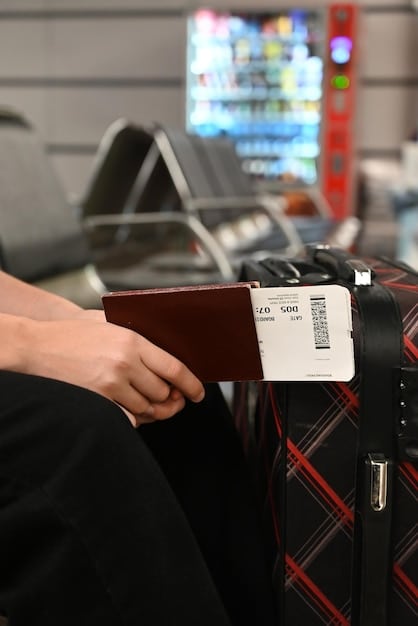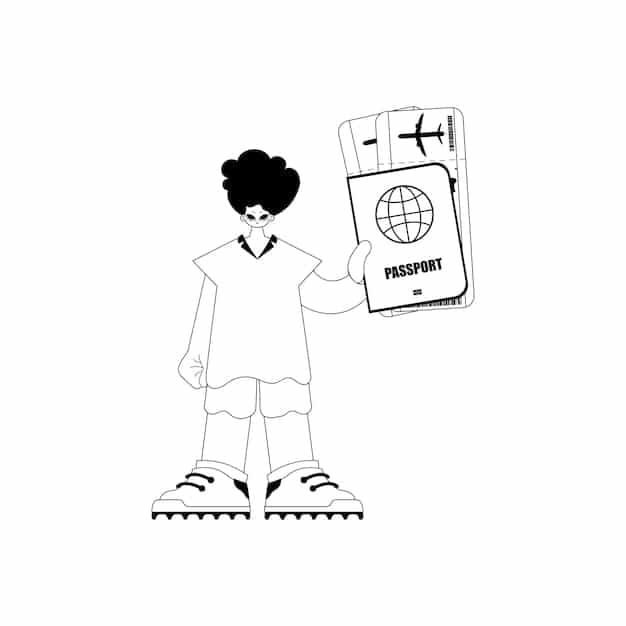US Passport Ready? Avoid 2025 Delays with Renewal Tips

Proactive passport renewal is crucial for US citizens traveling internationally in 2025 to bypass potential delays, especially with evolving regulations and increased demand, ensuring seamless border crossings and uninterrupted travel plans.
For many US citizens, international travel planning often begins with booking flights and accommodations, but a critical first step often overlooked is ensuring your passport is valid. The question, Is Your US Passport Ready? Avoid International Travel Delays in 2025 with These Renewal Tips, is more pertinent now than ever. Approaching a new year, travel regulations often shift, and the demand for passport services can surge, leading to significant processing delays. Preparing ahead can save you from last-minute stress, missed trips, and unexpected expenses, making your journey from dream to reality much smoother.
Understanding the Looming Passport Renewal Challenges for 2025
As we eye 2025, several factors converge to create a potentially challenging landscape for US passport renewals. Post-pandemic travel has seen an unprecedented rebound, leading to an increased demand for new passports and renewals. This surge often strains the processing capacity of the U.S. Department of State. Historically, periods following major global events or leading up to peak travel seasons have resulted in extended wait times, sometimes stretching into months. Understanding these systemic pressures is the first step toward a hassle-free renewal process.
Moreover, specific federal regulations and international travel requirements are continuously evolving. While no major changes related to passport validity are announced for 2025 yet, it’s prudent to remember that many countries require passports to be valid for at least six months beyond your intended departure date. This “six-month rule” can unexpectedly catch travelers off guard, rendering an otherwise valid passport insufficient for entry into their desired destination. Keeping abreast of these nuances is essential.
The “Six-Month Rule” and Why It Matters
Many popular international destinations enforce a rule requiring travelers’ passports to be valid for at least six months beyond their planned return date. This isn’t just a suggestion; it’s a strict entry requirement by many countries to cover unforeseen circumstances, such as extended stays due to illness or accidental overstays. If your passport doesn’t meet this criterion, even if it’s technically still “valid” according to its expiration date, you could be denied boarding by your airline or refused entry upon arrival.
- Common Pitfall: Travelers often check only the expiration date, forgetting the additional six-month buffer.
- Global Relevance: Countries in Europe, Asia, Africa, and South America widely adopt this rule.
- Airline Responsibility: Airlines are mandated to verify passport validity according to destination country rules, leading to denied boarding if requirements aren’t met.
The Department of State routinely updates its country-specific information, which includes entry and exit requirements. Before booking any international trip, a thorough check of these requirements for your destination is paramount. This simple proactive step can prevent significant disruption and financial loss. It’s not simply about having a valid passport; it’s about having a valid passport that complies with the specific requirements of your destination.
Beyond the six-month rule, some countries may also require a certain number of blank visa pages. Travelers taking extended trips with multiple destinations should ensure their passport has enough blank pages to accommodate entry and exit stamps, or any necessary visas. A passport filled with previous stamps might need renewal even if its validity period is still secure. These seemingly minor details are critical for a smooth journey.
Key Steps to Proactive Passport Renewal in the US
Starting the passport renewal process well in advance is the single most effective strategy to avoid delays. The US Department of State recommends applying for renewal at least 6-9 months before your passport expires, or before your planned international travel. This generous timeframe accounts for standard processing times and potential unforeseen delays, such as application errors or a sudden surge in demand.
The first step involves gathering all necessary documentation. For most adult renewals, you’ll need your most recent US passport, a new color photograph that meets specific requirements (no glasses, neutral expression, white background), and a completed DS-82 form. Ensure all information on the form is accurate and matches your supporting documents precisely. Errors, even minor ones, are among the leading causes of processing delays, as they often result in your application being flagged or returned for correction.
Gathering Your Documents: A Checklist for Success
A meticulous approach to document preparation can significantly streamline your renewal process. Start by locating your current US passport. This is crucial for verifying your identity and citizenship. Ensure it is undamaged and can be submitted with your application. If it’s lost or stolen, the process changes to a new passport application (DS-11), which requires an in-person appearance and additional documentation.
- Form DS-82: This is the application for US Passport Renewal by Mail. Fill it out completely and accurately.
- Passport Photo: Obtain a recent (within the last six months) color photograph. It must be 2×2 inches, taken against a plain white or off-white background, with a neutral facial expression or a natural, slight smile. No glasses are permitted unless medically necessary and accompanied by a doctor’s statement.
- Proof of Name Change (if applicable): If your name has changed since your last passport was issued (e.g., due to marriage or court order), you will need to submit original or certified copies of legal documents supporting the name change.
- Payment: Check the current fee schedule on the Department of State website. Payment is typically made via check or money order.
Submitting a flawless application package is crucial. Double-check every field on the DS-82 form, ensuring it matches your previous passport and any supporting documents. Any discrepancies can lead to your application being put “on hold” or returned, consuming valuable time. An important tip is to make copies of all submitted documents for your records before mailing, just in case any issues arise during processing.

Choosing the Right Renewal Method: Mail vs. Expedited Services
The standard renewal process for eligible adult passports is via mail. This is generally the most cost-effective option, but it also has the longest processing times. If you have a flexible travel schedule and are applying well in advance (6-9 months out), renewing by mail is often sufficient. The Department of State provides clear instructions for mailing your application packet, which includes your completed DS-82 form, previous passport, new photo, and payment.
However, if your travel plans are more immediate, or if you simply prefer extra peace of mind, expedited services are available. For an additional fee, you can request expedited processing, which significantly reduces the wait time. This service is particularly useful for those traveling within 3-4 months. You can also opt for 1-2 day delivery for your completed passport, adding another layer of speed to the process.
Expedited Processing: When Time is of the Essence
When there’s an urgent need for your passport, understanding the expedited options becomes critical. Expedited service dramatically cuts down on processing times for an extra fee. As of current guidelines, this service reduces the typical processing window to a few weeks, sometimes even less, depending on demand and specific circumstances. It’s an investment for travelers facing tight deadlines.
For truly emergency situations, such as documented life-or-death emergencies or urgent travel within a few days, an appointment at a Passport Agency or Center may be possible. These appointments are extremely limited and typically require proof of urgent travel or emergency. You must call to schedule these appointments, and you will need to bring all required documents and proof of travel to your scheduled appointment. This is the fastest, but also the most restricted, way to obtain a passport.
- Expedited by Mail: Add the expedited fee to your payment and clearly mark “EXPEDITED” on the outside of your envelope.
- Agency Appointments: For travel within 14 calendar days (or 2-3 business days for life-or-death emergencies), requiring an in-person visit.
- Private Expediting Services: Third-party companies can submit your application on your behalf, often offering faster turnaround times, but at a significantly higher cost. Research these services thoroughly for legitimacy and reputation.
It’s important to acknowledge that even with expedited services, there are no absolute guarantees, especially during periods of exceptionally high demand or unforeseen global events. Therefore, the strategic advantage remains applying as early as possible, even if you anticipate using expedited services. This buffer allows for problem-solving should any issues arise during the application review. Always check the official U.S. Department of State website for the most current processing times and fee structures before applying.
Monitoring Your Application and What to Do If Delays Occur
Once you’ve submitted your passport renewal application, the waiting begins. Fortunately, the US Department of State provides an online status checker tool. By entering your last name, date of birth, and the last four digits of your social security number, you can track the progress of your application. This tool will inform you when your application has been received, is in process, and when your passport has been mailed. It’s a valuable resource for staying informed and managing your expectations.
Despite careful planning, delays can sometimes occur. If your travel date is approaching and your passport status hasn’t updated as expected, or if you receive a notification that your application is on hold, it’s essential to act promptly. First, review any correspondence from the Department of State carefully to understand the reason for the delay. It could be something minor, like a photo that doesn’t meet specifications, or a missing signature.
Addressing Common Application Issues and Delays
Several common issues can lead to passport application delays. Incorrectly filled forms are a frequent culprit; even a small typo or a missing piece of information can halt the process. Photos that don’t meet strict requirements for size, background, or facial expression are another common reason for applications being returned. Ensuring meticulous attention to detail on these elements can preempt many potential issues.
If your application is returned or put on hold, respond immediately with the requested information or corrections. The Department of State typically provides clear instructions on how to remedy the situation. Delays often compound, so a quick and accurate response is crucial. If your travel is imminent and you’re experiencing a delay, consider contacting the National Passport Information Center. They can provide specific advice and sometimes assist in escalating urgent cases, especially if you have an upcoming flight within 14 days and can prove it.
- Inaccurate Form DS-82: Double-check every field, especially name, date of birth, and Social Security number.
- Non-Compliant Photo: Ensure it meets all official guidelines for size, background, and facial expression. No glasses.
- Missing Documents: Confirm all required documents, including your old passport, are enclosed.
- Incorrect Payment: Verify the fee amount and ensure your check or money order is correctly filled out.
It’s also advisable to keep a copy of your submitted application and all mailing receipts. If you need to contact the Passport Agency about a delay, having your tracking numbers and application details readily available will assist their customer service representatives in quickly locating your file. Proactive communication and organized records are your best allies when navigating potential processing setbacks.
Post-Renewal Checklist: What to Do Once Your New Passport Arrives
Receiving your new US passport is a moment of relief and excitement, signaling readiness for your international adventures. However, the process isn’t quite complete. The very first thing you should do upon receiving your new passport is to sign it on the designated signature line. An unsigned passport is not considered valid for travel and could cause issues at border control.
Next, carefully review all the information printed on your new passport. Check for any discrepancies in your name, date of birth, place of birth, and gender. While errors are rare, they do happen, and it’s much easier to correct an issue before your travel date. If you find any errors, contact the National Passport Information Center immediately for guidance on how to get it corrected.

Securing Your New Passport and Old Documents
Once you’ve verified all the details and signed your new passport, it’s time to secure it. Treat your passport as a highly valuable document – because it is. Store it in a safe, secure place at home, away from potential theft or damage. Consider investing in a fireproof safe or a locked drawer. When traveling, carry it securely on your person, ideally in a travel wallet or money belt, to prevent loss or theft.
What about your old, canceled passport? The Department of State typically returns your old passport along with your new one. Do not discard your old passport, especially if it contains valid visas for other countries. While canceled, it can still serve as proof of previous travel or visas. Store your old passport securely, separate from your new one. Having a digital copy (photo or scan) of your new passport’s information page and any active visas can also be a lifesaver in case of loss or theft while abroad, though it does not replace the physical document itself.
- Sign It: Immediately sign your new passport in the designated area.
- Review Information: Double-check all personal details for accuracy.
- Secure Storage: Keep your new passport safe at home and with you during travel.
- Retain Old Passport: Your old, canceled passport may still hold valid visas or serve as valuable historical travel proof.
- Digital Copies: Keep secure digital copies of your passport’s main page and any critical visas on your phone or cloud storage.
Remember that your passport is your primary identification for international travel. Protecting it is protecting your ability to explore the world. By following these post-renewal steps, you ensure both its validity and your peace of mind throughout your travel adventures. These minor precautions can prevent major headaches down the line, ensuring a smooth and enjoyable international experience, from departure to return.
Future-Proofing Your Travel Plans: Beyond the Passport
While securing a valid US passport is fundamental for international travel, a truly prepared traveler extends their foresight beyond just the passport itself. As global travel continues to evolve, so do the myriad requirements and recommendations that can impact your journey. Looking ahead to 2025 and beyond, it’s crucial to adopt a holistic approach to travel readiness, incorporating various aspects from health to connectivity.
One increasingly important aspect is understanding the digital entry requirements for certain regions. For instance, the European Travel Information and Authorisation System (ETIAS) is expected to become operational in 2025. This electronic travel authorization will be a mandatory requirement for visa-exempt non-EU nationals traveling to the Schengen Area, including US citizens. Much like the ESTA for the US, applying for ETIAS in advance will be critical to avoid being denied entry, adding another layer of pre-travel planning that goes beyond just passport validity.
Embracing Digital Travel Credentials and Health Protocols
The landscape of international travel is increasingly embracing digital solutions. Beyond the ETIAS, other countries may start implementing similar digital entry systems or even digital health passes. Travelers should be prepared for a future where a physical passport alone might not suffice, and digital credentials accessed via smartphones could become part of the routine. Staying informed about these technological shifts is a key part of future-proofing your travel. Subscribing to travel alerts from the Department of State or reputable travel news sources can keep you updated on these developments.
Health protocols also play an ever-present role in international travel planning. While many pandemic-era restrictions have eased, the possibility of new health-related requirements, such as vaccination proofs or health declarations, always remains. Checking the health advisories for your destination country and ensuring you have any required vaccinations or health certifications is paramount. Travelers should maintain digital and physical copies of relevant health records, especially for routine vaccines recommended for international travel by the CDC.
- ETIAS and Other E-Visas: Research and apply for any necessary electronic travel authorizations well in advance.
- Digital Health Passes: Stay informed about potential digital health credential requirements.
- Travel Insurance: Consider comprehensive travel insurance that covers health emergencies, trip cancellations, and unforeseen events.
- Smart Traveler Enrollment Program (STEP): Enroll with the US Embassy for alerts and assistance while abroad.
- Financial Preparedness: Notify your bank of travel plans and have multiple payment methods available.
Finally, don’t overlook practical considerations like travel insurance. Comprehensive travel insurance can cover medical emergencies, trip interruptions, and lost luggage, providing an invaluable safety net. Enrolling in the Smart Traveler Enrollment Program (STEP) with the US Embassy or consulate in your destination country is also a wise move, allowing them to contact you in an emergency and provide pertinent information. These additional layers of preparation, beyond just keeping your passport current, build a resilient travel plan ready for the complexities of modern international travel.
| Key Point | Brief Description |
|---|---|
| 📅 Renew Early | Apply 6-9 months before expiration or travel to avoid peak season delays. |
| ✈️ 6-Month Rule | Check if your destination requires passport validity for 6+ months beyond your trip. |
| 📝 Document Prep | All forms and photos must strictly meet requirements to prevent delays. |
| 📊 Track Status | Use the online tool and contact the Passport Center for any urgent issues. |
Frequently Asked Questions About Passport Renewal
It’s highly recommended to apply for your US passport renewal at least 6 to 9 months before your passport expires or before your intended international travel date in 2025. This timeframe accounts for standard processing times and potential unforeseen delays, ensuring your passport is ready.
The “six-month rule” means many countries require your passport to be valid for at least six months beyond your planned date of departure from their country. Even if your passport is technically still valid, it might not be accepted if it falls within this six-month window, potentially causing denied boarding or entry for your 2025 trips.
Yes, expedited processing services are available for an additional fee if your 2025 travel is urgent. You can choose expedited service by mail or, for very imminent travel (within 14 days), you may qualify for an appointment at a Passport Agency, requiring proof of urgent travel. Always check current processing times on the official website.
Common mistakes include submitting an incomplete or incorrectly filled DS-82 form, providing a passport photo that doesn’t meet strict requirements (e.g., wearing glasses, incorrect size), or forgetting to include your previous passport. These errors can lead to significant delays, so careful review is essential for hassle-free 2025 travel.
Yes, the European Travel Information and Authorisation System (ETIAS) is expected to become operational in 2025. US citizens traveling to countries in the Schengen Area will need to apply for this electronic travel authorization in advance. It’s a mandatory pre-travel requirement similar to the ESTA for entry into the United States.
Conclusion
As international travel continues its robust return, the need for proactive passport planning has never been more critical for US citizens. The question, “Is Your US Passport Ready? Avoid International Travel Delays in 2025 with These Renewal Tips,” serves as a crucial reminder to prioritize this foundational element of your journey. By understanding potential challenges, meticulously preparing documentation, utilizing available services wisely, and remaining vigilant about evolving global requirements, you can navigate the renewal process with confidence. A well-planned passport renewal is not just administrative task, but an investment in peace of mind, ensuring your international adventures in 2025 and beyond are marked by smooth transitions rather than unexpected obstacles.





